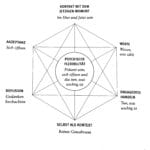The Hedgehog’s Dilemma isn’t just some dusty old philosophy idea; it’s something we all grapple with every single day. It’s that push and pull we feel in our relationships—the desire to be close to others while also protecting ourselves from getting hurt. This article delves into the nuances of this age-old dilemma, exploring its origins, psychological implications, and how we can navigate its challenges in the modern world.
Understanding the Hedgehog’s Metaphor
A Cozy Conundrum: Decoding the Core Concept
Imagine a group of hedgehogs on a frigid winter night. They huddle together, seeking warmth and comfort. But their protective quills prick each other, causing pain. They pull apart, only to be drawn back together by the cold. This constant push and pull, the dance between closeness and pain, is the essence of the Hedgehog’s Dilemma. It’s a potent metaphor for the complexities of human connection, where our desire for intimacy is often countered by the fear of vulnerability and emotional injury. This central conflict probably resonates with anyone who has ever struggled to balance the desire for connection with the fear of getting hurt.
[https://www.lolaapp.com/q-eqchi-language]
From Philosophy to Psychology: Tracing the Dilemma’s Roots
The Hedgehog’s Dilemma wasn’t pulled out of thin air. It has a rich history, rooted in the philosophical musings of Arthur Schopenhauer. In his 1851 work, Parerga and Paralipomena, Schopenhauer used the hedgehog analogy to illustrate the inherent tension in human relationships. He argued that true intimacy is often elusive due to our inherent self-interest and capacity to inflict pain, even unintentionally. Decades later, Sigmund Freud, in his 1921 work Group Psychology and the Analysis of the Ego, incorporated the dilemma into his theories, solidifying its place in psychological discourse. Freud viewed the hedgehogs as representing the conflict between individual needs and the demands of social groups, a tension that continues to shape how we interact today.
The Hedgehog’s Dilemma in Modern Life
Modern Relationships: The Prickly Dance of Intimacy and Distance
The Hedgehog’s Dilemma isn’t confined to dusty philosophical texts; it plays out in our everyday lives. It’s present in the hesitant first date, the cautious approach to a new friendship, the unspoken tension at a family gathering. In romantic relationships, we yearn for deep connection, that feeling of being truly seen and understood. But opening ourselves up also means risking heartbreak and rejection. Friendships offer support and companionship, yet they can bring the sting of betrayal or disappointment. Even within families, where love is often assumed to be unconditional, friction and emotional prickliness can arise.
The Digital Dilemma: Connection and Conflict Online
The digital age adds a new layer of complexity. Social media promises connection at our fingertips, but it can also amplify our fears of judgment and rejection. We curate online personas, often hiding our vulnerabilities behind carefully crafted profiles. This can make genuine connection feel even more elusive, leaving some feeling more isolated than ever. Current research is exploring how social media affects our relationships and sense of self, suggesting that the interplay between online and offline interactions is crucial to understanding the modern Hedgehog’s Dilemma.
Finding the Sweet Spot: Strategies for Building Better Connections
Navigating the Thorny Issue of Closeness: Practical Strategies
So, how do we navigate this thorny issue of closeness? While there’s no magic formula, there are steps we can take to find a healthier balance. It’s not about eliminating our “quills” altogether—those defenses we’ve developed to protect ourselves. Instead, it’s about managing them effectively.
1. Know Your Own Quills: Self-awareness is essential. Understanding your own sensitivities, fears, and defense mechanisms is the first step. What triggers you to pull back? What are you afraid of? Reflecting on these questions can provide a roadmap to your own emotional landscape.
2. Set Healthy Boundaries: Boundaries aren’t walls; they’re guidelines for healthy interaction. They define where your personal space begins and ends, allowing for connection while protecting your well-being. Communicating your needs and limits clearly and respectfully is key.
3. Communicate Openly and Honestly: Vulnerability can be scary, but it’s also the foundation of deep connection. Creating a safe space for open and honest communication—where you can express your needs and fears without judgment—can foster trust and intimacy.
4. Manage Expectations: It’s important to remember that relationships are a continuous dance, a constant adjustment of closeness and distance. There will be times when you step closer and times when you need to step back. This ongoing negotiation is a normal part of any healthy relationship.
5. Seek Support: If you find yourself consistently struggling with the Hedgehog’s Dilemma, seeking professional support can be beneficial. A therapist can help you explore underlying issues related to intimacy and develop healthier relationship patterns.
The Ongoing Journey of Connection: Embracing the Messy Beauty
Human connection is inherently messy. It’s a blend of joy and sorrow, closeness and distance, laughter and tears. The Hedgehog’s Dilemma isn’t about achieving perfect, pain-free relationships; it’s about learning to navigate the inherent complexities with wisdom and compassion. It’s about accepting that vulnerability is a part of the process, but it doesn’t have to be terrifying. By understanding the dilemma and its influences, we can begin to manage the pricks, savor the warmth, and find that optimal distance that allows us to truly connect with the people in our lives. It’s a lifelong journey, but it’s a journey worth taking.
- Unlikely Fatherhood: the beginning of the sea: J-Drama Analysis - March 16, 2025
- White Cross Uniforms: Premium Scrubs Now - March 16, 2025
- T-62 Tank: Cold War Legacy, Modern Upgrades - March 16, 2025

















1 thought on “Navigating the Hedgehog’s Dilemma: The Delicate Dance of Intimacy and Distance in Modern Relationships”
Comments are closed.